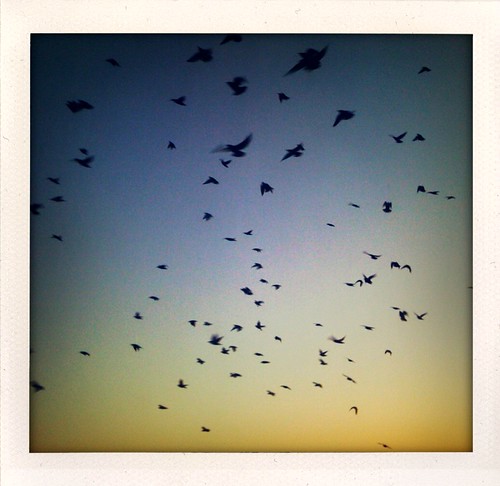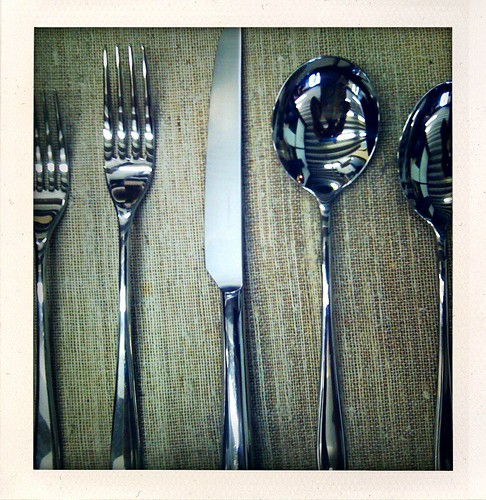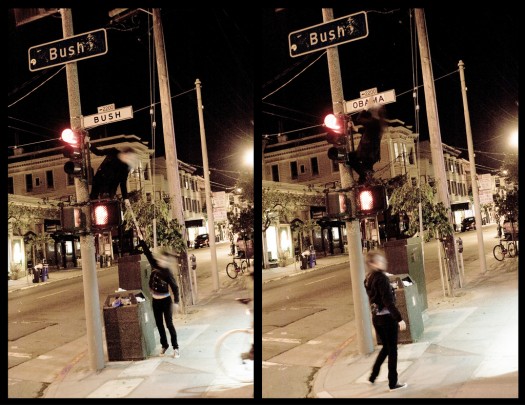I really geek out out on glimpses of the marked-up copy of other writers, so I was pretty fascinated to see a page of a Presidential speech-in-progress. If you click through to the zoomed-in page, you'll see that all of Obama's notes are all copy-edits; there are no developmental "what I'm trying to say here"-style edits. Not sure what that means, but I thought it was interesting. The Flickr caption indicates that the photo was taken "in the Oval Office, Sept. 9, 2009, in preparation for the president's address to a joint session of Congress." Cool.
Category: photo
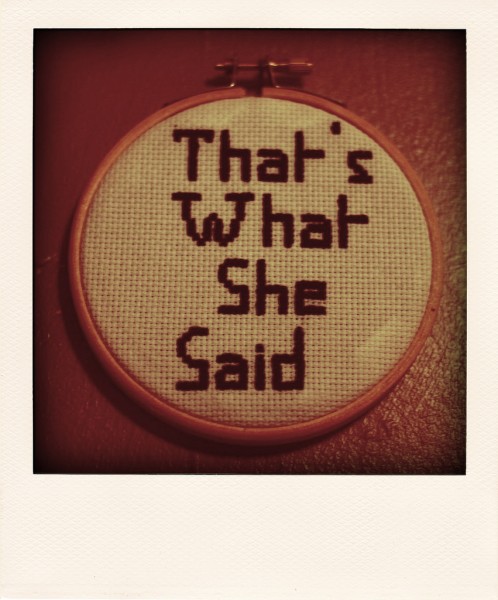 Genius stitching and polaroid by: That Kate.
Genius stitching and polaroid by: That Kate.Transbay bird swirl
Perched among the tall buildings in downtown San Francisco, my office can feel like a nest in a tall tree. Yesterday evening, the birds that live atop the Transbay terminal swirled up to, and around, the windows of our conference room, and the aerie-like feeling was stronger than ever. One bird even landed, briefly, on the ledge of the window. I have no idea what kind of birds they are, what brought them to us, or what they hope to achieve. But I am in awe of them.
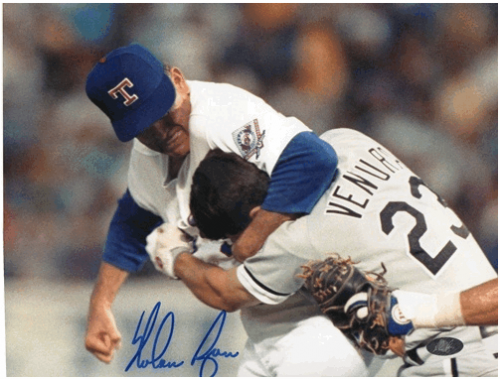
You autograph photos of yourself using Robin Ventura's head as a speedbag. And, they sell for $100 each on ebay.
Great design hits you on many levels. Designers love to talk about closing the door of a BMW. It feels different. And this feeling may not even register in the conscious mind, but it matters. The feeling of solidity and integrity during that action is unique and lasting, even though it occupies a tiny sliver around the experience of driving. You may not consciously notice it, but your mind registers it and you body remembers it.I hesitate to admit this in a public forum, but I don't think I've ever purchased a new piece of silverware. Our silverware drawer is a hodgepodge of airline spoons, thrift store forks, garage sale knives, odds and ends of various shapes and sizes. But you've got to wonder whether the experience of eating wouldn't be greatly enhanced — even unconsciously — by great silverware, like the set above by craftsman David Mellor. I saw it yesterday at Heath Ceramics in Sausalito, and even a philistine like me could tell that it's got something going on. For $160, you can find out for yourself.If you do, listen to your subconscious, and let me know what it says.
Dream team

Saul Steinberg's cover for the first edition The Americans by Robert Frank. Publisher Robert Delpire: "The only point of disagreement was the cover. I insisted right away on using a drawing by Saul Steinberg, whom I had met and whose work I liked. Frank said, 'It's a book of photos, we could use a photo.' I told him, 'You can use a photo for the American edition, but let me use a Steinberg drawing.' But when I reprinted the book in 1986, I used a photograph because I had discovered, basically, that he was right."
Photographer Robert Frank is known for a few things, primarily The Americans, a ground-breaking book of photography published in the late 50's. He is also known for avant-garde film-making, e.g., Pull My Daisy, and his never-released Rolling Stones documentary with an unprintable name.We checked out SFMOMA's 50th anniversary retrospective of The Americans today, and I was astonished at another of Frank's skills: Grant-writing. In order to fund the gathering of the photos that became The Americans, he applied for a Guggenheim Fellowship. I've pasted his clear, simple, two-part essay below.
Part 1: Frank's brief summary of the proposal
To photograph freely throughout the United States, using the miniature camera exclusively. The making of a broad, voluminous picture record of things American, past and present. This project is essentially the visual study of a civilization and will include caption notes; but it is only partly documentary in nature: one of its aims is more artistic than the word documentary implies.
Part 2: The full statement of intent
I am applying for a Fellowship with a very simple intention: I wish to continue, develop and widen the kind of work I already do, and have been doing for some ten years, and apply it to the American nation in general. I am submitting work that will be seen to be documentation — most broadly speaking. Work of this kind is, I believe, to be found carrying its own visual impact without much work explanation. The project I have in mind is one that will shape itself as it proceeds, and is essentially elastic. The material is there: the practice will be in the photographer's hand, the vision in his mind. One says this with some embarrassment but one cannot do less than claim vision if one is to ask for consideration. "The photographing of America" is a large order — read at all literally, the phrase would be an absurdity. What I have in mind, then, is observation and record of what one naturalized American finds to see in the United States that signifies the kind of civilization born here and spreading elsewhere. Incidentally, it is fair to assume that when an observant American travels abroad his eye will see freshly; and that the reverse may be true when a European eye looks at the United States. I speak of the things that are there, anywhere and everywhere — easily found, not easily selected and interpreted. A small catalog comes to the mind's eye: a town at night, a parking lot, a supermarket, a highway, the man who owns three cars and the man who owns none, the farmer and his children, a new house and a warped clapboard house, the dictation of taste, the dream of grandeur, advertising, neon lights, the faces of the leaders and the faces of the followers, gas tanks and postoffices and backyards. The uses of my project would be sociological, historical and aesthetic. My total production will be voluminous, as is usually the case when the photographer works with miniature film. I intend to classify and annotate my work on the spot, as I proceed. Ultimately the file I shall make should be deposited in a collection such as the one in the Library of Congress. A more immediate use I have in mind is both book and magazine publication.
Frank was awarded a fellowship, which amounted to $3,600, and he used this to travel in a long loop around the US in 1955–6. That "more immediate use" that he refers to in the final sentence turned into The Americans, a stunning document that is every bit as interesting 50 years later. The exhibition is captured in an extended version of The Americans, including contact sheets and commentary.
The NYT's Lens blog recently posted a couple of great articles about the photographers who captured the Tienanmen Square protests in 1989. The first offers four riveting oral histories from photographers who captured the "Tank Man" in his moment of defiance, and the second adds a new twist: this amazing image from street level.
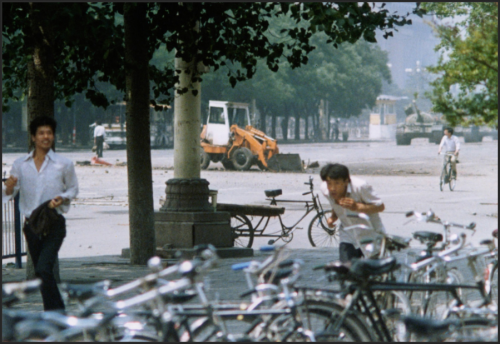 Disorder. People fleeing. This was happening as the Tank Man, seemingly so calm, stood in the street. I also think it's interesting that all the men in the photo are wearing — as a commenter on the NYT blog put it — "the same drab clothes." A true illustration of how much has changed in China in the last 20 years.
Disorder. People fleeing. This was happening as the Tank Man, seemingly so calm, stood in the street. I also think it's interesting that all the men in the photo are wearing — as a commenter on the NYT blog put it — "the same drab clothes." A true illustration of how much has changed in China in the last 20 years.The Roshomon-like details in all of the photographers' stories are vivid and heartbreaking: "Vehicles were smoldering," "a line of students facing a line of soldiers and a column of tanks," "another volley of shots rang out from where the tanks were, and people began ducking, shrieking, stumbling and running," "some guy in a white shirt runs out in front," "a man waving two plastic shopping bags," "waving his jacket and shopping bag," "remonstrating with the tank driver in an act of defiance," "he then disappeared into the crowd," "the PSB (Public Security Bureau) grabbed him and ran away."
And then what happened?
Charlie Cole: "I then placed the tank roll in a plastic film can and wrapped it in a plastic bag and attached it to the flush chain in the tank of the toilet."Stuart Franklin: "The film was smuggled out in a packet of tea by a French student and delivered to the Magnum office in Paris."Jeff Widener: "I gave all my rolls of film to [someone named] Kurt/Kirk who smuggled it back to the A.P. office in his underwear. The long-haired college kid was wearing a dirty Rambo T‑shirt, shorts and sandals." Arthur Tsang Hin Wah: "A colleague rode over on a bike and picked up the film."And Terril Jones, the reporter who captured the shot at street level: "I never published them, and only showed them to a few friends and fellow reporters."And the rest is history. That keeps unfolding, I guess.
Okay, one last political thing. In the wee hours before yesterday's inauguration, a genius prankster named Alex Zecca reportedly covered every "Bush" street sign from downtown to the Marina with a sticker that said "Obama." I heard about it when I got into work, but missed the chance to see it for myself. Luckily, Vanessa Naylon saw it happen. Awesome.

